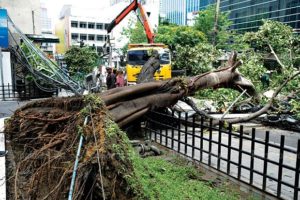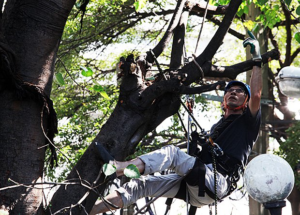
Tracking down Bangkok’s missing ‘tree surgeons’
9 December 2018
With strong winds, heavy rains and wobbling root tap systems, trees along streets are often deemed as the cause of accidents.
The latest fatal case took place in May last year when a large tree situated in front of the Alma Link Building near the Central Chidlom Department Store toppled over after it was shaken by heavy rain and wind. The tree also brought down power poles which crashed into three motorcycles, killing one woman, and injuring two others on Chidlom Road.
Last year, the Bangkok Metropolitan Administration (BMA) estimated there were 1,925 trees on Bangkok’s roads, sois and public parks which were at risk of falling. These trees are under the jurisdiction of the BMA and located in close proximity to people, commuters and motorists.
To reduce the risks of falling trees, emeritus professor Decha Boonkham, a national artist and founder of the Thai Association of Landscape Architecture, said the country needs more professional experts.
The problem of toppling trees stems from a lack of knowledge on how to properly take care of them.
Emeritus professor Decha — often called “Ajarn Decha” — said trees are an essential part of the city.

The presence of trees enhances both the aesthetic and financial value of surrounding property. Needless to say, trees also solve air pollution problems and combat climate change.
“Trees [on Bangkok’s streets] are often removed by cutting near the base of the trunk. This form of tree removal can be dangerous if the process is not adequately planned and executed. We have to pay attention to the selection of trees, inspection work, positioning, and tree felling techniques,” Mr Decha told a recent seminar on “Sustainable Management of Large Trees.”
The seminar, in Bangkok, was hosted by BIG Trees, Thammasat University, and Thai Association of Landscape Architects.
A part of the seminar included a workshop held at Suan Pakkad Palace Museum in Bangkok, where seminar attendees learned about planting design, landscape design, as well as witnessed a demonstration by a “tree surgeon” on how to cut and remove trees correctly.
The seminar was also held to demonstrate the importance of tree conservation and the need for “tree surgeons” to help protect urban trees.
Another name for a tree surgeon is an arborist, which refers to someone whose job concerns tree cultivation, management and the study of individual trees, shrubs, vines and other perennial woody plants.
However, finding a fully qualified arborist is extremely difficult in Thailand, with only a few upmarket gardens, such as the Royal Palace, embassies and upscale hotels having in-house arborists.
This is not necessarily because the country lacks knowledge in arboricultural education, but rather because most tree experts in Thailand come from Kasetsart University’s Faculty of Forestry, where there is an emphasis on forests and not urban trees.
The state of urban tree conservation and management in Bangkok is similar to that of Singapore more than a decade ago. At that time, professional arborists were virtually unheard of.
However, cities that give priority to urban tree conservation use arborists who are professionally trained to take care of trees. A certified arborist can earn a handsome income.
Those working in Singapore earn about 80,000 baht a month, according to information from BIG Trees, a local urban conservation network.
Singapore started using arborists more than a decade ago. As a result of the use of legal instruments and incentives, the city was able to keep big trees alive and thriving in an urban jungle.
The Singaporean government has issued laws to control the height of buildings and electricity poles and offered incentives to developers to safeguard big trees.
Professionally trained arborists can help decide whether or not a tree should be removed and they possess the skill and equipment to safely and efficiently remove trees.
With proper maintenance, trees can add aesthetic and economic value to property. Poorly maintained trees, on the other hand, can be a significant liability.
________________________________________
BANGKOK GREEN AREA
A Green City report by The Economist Intelligence Unit (EIU) in 2016 noted Bangkok as being “below average” in terms of “Land Use and Buildings”, a category in assessing the city’s population density and green space per capita.
According to the Bangkok Metropolitan Administration (BMA), green space in Bangkok is about 5.46 square metres per capita, a fraction of the EIU’s regional average of 39 square metres, while Singapore’s averaged an amazing 66 square metres.
Since green space is a key factor in enhancing a city’s quality of life and, in turn, property values, Bangkok falls well below regional competitors like Jakarta. Only Hanoi scores lower, according to CBRE Thailand.
________________________________________
BENEFIT OF TREES
Beyond the basic biology of trees, they also reduce our carbon footprint in various ways. Here are some of the many environmental benefits of planting trees:
• Trees also absorb ozone, which is a potent greenhouse gas.
• The shade from a single tree can save the same amount of energy required by 10 room-sized air conditioners need to run for 20 hours a day.
• Using trees to provide windbreaks around your house can reduce your heating bill — and the attendant energy consumption — by 20 to 50% per year.
SOURCE: ONETREEPLANTED (A US-based non-profit organisation)
Source: https://www.bangkokpost.com/news/special-reports/1590494/tracking-down-bangkoks-missing-tree-surgeons

